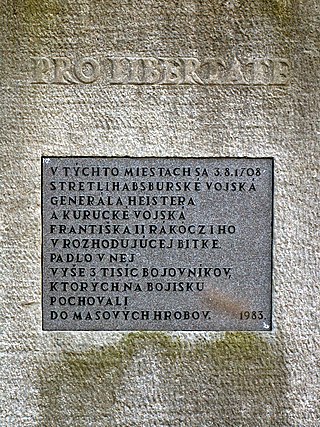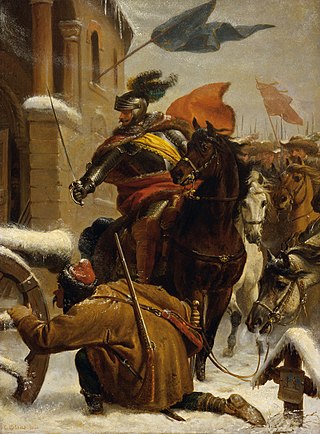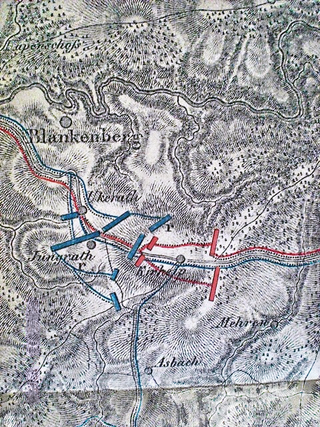
The Battle of Nördlingen took place on 6 September 1634 during the Thirty Years' War. A combined Imperial-Spanish force inflicted a crushing defeat on the Swedish-German army.

The second Battle of Nördlingen was fought on August 3, 1645 southeast of Nördlingen near the village of Alerheim. France and its Protestant German allies defeated the forces of the Holy Roman Empire and its Bavarian ally.

Matthias Gallas, Graf von Campo und Herzog von Lucera was an Italian professional soldier during the Thirty Years' War. He distinguished himself in the first half of the war in service of the Catholic League, in the War of the Mantuan Succession, and as one of Albrecht von Wallenstein's Generals. After carrying out the dismissal and elimination of Wallenstein, Gallas became acting supreme commander of the Imperial Army three times between 1634 and 1647 but he never held the function or authority of a Generalissimo.

The Battle of Dessau Bridge was a significant battle of the Thirty Years' War between Danish Protestants and the Imperial German Catholic forces on the Elbe River outside Dessau, Germany on 25 April 1626.

The Battle of Bergen on 13 April 1759 saw the French army under de Broglie withstand an allied British, Hanoverian, Hessian, Brunswick army under Prince Ferdinand of Brunswick near Frankfurt-am-Main during the Seven Years' War.

The Battle of Trenčín or Battle of Trencsén was fought between the Hungarian Kuruc forces of Francis II Rákóczi and the Imperial Army of the Habsburgs. It was part of Rákóczi's eight-year-long War of Independence.

The Battle of Tuttlingen was fought in Tuttlingen on 24 November 1643 between the French army in Germany led by Marshal Josias Rantzau, composed of French soldiers and the so called Weimarans or Bernhardines, German troops once in service of Bernard of Saxe-Weimar. They were defeated by the forces of the Holy Roman Empire, Bavaria and Spain led by Franz von Mercy. Technically, Mercy led a military force composed of his Bavarian army, supported by Imperial, Spanish, and Lorrainer troops. The French army was wiped out in a surprise attack in heavy snowfall along with French strategic gains since 1638. The French court suppressed the defeat and it remains largely unknown today, even among historians of the war.

The Battle of Drakenburg took place on 23 May 1547 to the north of Nienburg, between the Protestant army of the Schmalkaldic League and the imperial troops of Eric II, Duke of Brunswick-Lüneburg, Prince of Calenberg. It resulted in an imperial defeat. Eric was forced to swim over the Weser River to save his own life. As a consequence, the imperialists left northern Germany, contributing to freedom of religion for Lutherans and Catholics in northern Germany.

The War of the Jülich Succession was a war of succession in the United Duchies of Jülich-Cleves-Berg. It lasted between 10 June 1609 and 24 October 1610, resumed in May 1614 and finally ended on 13 October 1614. The first round of the conflict pitted Catholic Archduke Leopold V against the combined forces of the Protestant John Sigismund, Elector of Brandenburg and Wolfgang Wilhelm, Count Palatine of Neuburg, ending in the former's military defeat. The representatives of Brandenburg and Neuburg later entered into a direct conflict after their religious conversion to Calvinism and Catholicism respectively. The conflict was further complicated by the involvement of Spain and the Netherlands making it part of the Eighty Years' War, as well as the European wars of religion. It was finally settled by the Treaty of Xanten, whose provisions favoured Spain.

The Battle of Párkány was fought between October 7–9, 1683 in the town of Párkány, in the Ottoman Empire, and the area surrounding it as part of the Polish-Ottoman War and the Great Turkish War. The battle was fought in two stages. In the first stage Polish troops under John III Sobieski were defeated by the Ottoman army under Kara Mehmed Pasha on October 7, 1683. In the second stage Sobieski, supported by Austrian forces under Charles V, Duke of Lorraine, defeated the Ottoman forces, which were supported by the troops of Imre Thököly, and gained control of Párkány on October 9, 1683. After the Ottoman defeat, the Austrians would besiege Esztergom and captured it at the end of 1683.

In the siege of Dorsten, an Imperial force under Melchior von Hatzfeldt besieged the Hessian garrison in the town of Dorsten from 16 July 1641 to 19 September 1641 during the Thirty Years' War. The garrison capitulated on 18 September 1641 and moved out of the town the following day.
The Hessian War, in its wider sense sometimes also called the Hessian Wars (Hessenkriege), was a drawn out conflict that took place between 1567 and 1648, sometimes pursued through diplomatic means, sometimes by military force, between branches of the princely House of Hesse, particularly between the Landgraviate of Hesse-Cassel and the Landgraviate of Hesse-Darmstadt. It was triggered by a division of inheritance following the death of the last landgrave of all Hesse, Philip I in 1567.

Carl von Rabenhaupt was a Bohemian Hussite nobleman who fought in Dutch and Hessian service during the Thirty Years War and came out of retirement to help the Dutch defend Groningen during the Franco-Dutch War. He made a name for himself as a siege specialist, taking or successfully defending many fortified cities along the Dutch-German border.
The Battle of Rinnthal was the heaviest battle of the Palatine uprising and took place on 17 June 1849 near Rinnthal in the Annweiler valley in Europe. The revolutionary troops under August Willich tried in vain to halt the advance of Prussian troops on Landau.

The Cologne Diocesan Feud, also called the Neuss War or Burgundian War, was a conflict, which began in 1473, between the Archbishop of Cologne, Ruprecht of the Palatinate and the Landstände of his archbishopric. As a result of the involvement of Charles the Bold of Burgundy and, eventually, the Holy Roman Empire the matter at times assumed a European dimension. It finally ended when Ruprecht died in 1480.
The Düsseldorf Cow War was a military conflict over the status of church property in the duchies Jülich and Berg. It lasted between June and December 1651, pitting the Catholic Palatinate-Neuburg against the Protestant Margraviate of Brandenburg. It ended in peaceful settlement, confirming the distribution of church property on the basis of the year 1651.

Johann von Geyso was a German nobleman and General-Lieutenant, who fought during the course of the Thirty Years' War. After studying in a Dutch military academy, Geyso fought as a mercenary in the armies of Sweden, Bohemia, Denmark and the German Protestant Union. In 1628, having gained significant experience in warfare he returned to his native Hesse-Kassel which he served until the end of the Thirty Years' War, reaching the rank of commander in chief of the Langraviate's forces and becoming ennobled.

The Battle of Kempen, also known as Battle of the Kempen Heights, or Battle of Hückelsmay, took place on 17 January 1642 during the Thirty Years' War, outside Kempen, now part of North Rhine-Westphalia. A combined Franco-Hessian army, led by de Guébriant and von Eberstein respectively, defeated an Imperial force under General de Lamboy.

Guillaume III de Lamboy de Dessener, 1590 to 1659, was a Field Marshal in the Imperial Army, who served in the 1618 to 1648 Thirty Years War, and the 1635 to 1659 Franco-Spanish War.

The Battle of Kircheib was a military engagement during the War of the First Coalition. On 19 June 1796, French and Austrian troops clashed at Kircheib in the Westerwald uplands in present-day Germany. Sometimes it is called the Battle of Uckerath after another nearby village, Uckerath, which belongs today to Hennef.

















